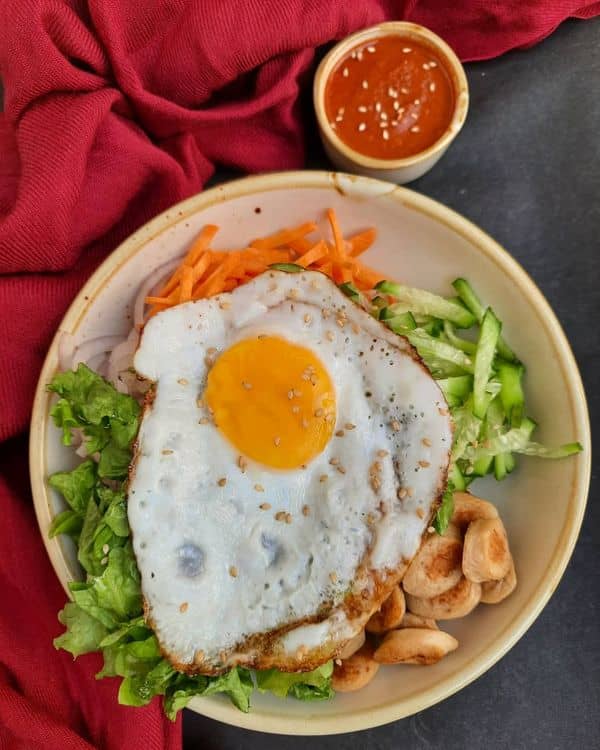A delicious and colorful Korean rice dish topped with a variety of vegetables, meat, and a fried egg, served with spicy gochujang sauce.

Stuck mid-recipe?
Chefadora AI has the answer - timers, swaps, step-by-step help.
Ingredients
Vegetables and Toppings
 cooked rice1cup
cooked rice1cup spinach1cup
spinach1cup carrots, julienned1cup
carrots, julienned1cup zucchini, julienned1cup
zucchini, julienned1cup bean sprouts1cup
bean sprouts1cup garlic, minced2clove
garlic, minced2clove- ground beef1lb
 eggs fried eggs2
eggs fried eggs2 gochujang chilli sauce2tbsp
gochujang chilli sauce2tbsp sesame oil1tbsp
sesame oil1tbsp soy sauce1tbsp
soy sauce1tbsp sesame seeds1tbsp
sesame seeds1tbsp
Want to keep this recipe for later? We can email it to you!
Nutrition (per serving)
Calories
540.0kcal (27%)
Protein
35.9g (71.8%)
Carbs
42.8g (15.56%)
Sugars
6.2g (12.3%)
Healthy Fat
12.5g
Unhealthy Fat
8.7g
% Daily Value based on a 2000 calorie diet
How to make Bibimbap
Preparation of Ingredients
- Step 1
Cook the rice according to package instructions.
- Step 2
Blanch the spinach in boiling water for a minute, then drain and squeeze out excess water.
- Step 3
Sauté the carrots and zucchini separately in a pan with a little sesame oil until tender.
- Step 4
Sauté the bean sprouts with minced garlic until cooked.
- Step 5
Cook the ground beef in a pan, adding soy sauce and sesame oil for flavor.
Assembling the Bibimbap
- Step 1
In a bowl, place a serving of cooked rice.
- Step 2
Arrange the sautéed vegetables and ground beef on top of the rice.
- Step 3
Add a fried egg on top.
- Step 4
Drizzle with gochujang sauce and sprinkle sesame seeds before serving.
Want to keep this recipe for later? We can email it to you!
Nutrition (per serving)
Nutrition (per serving)
Calories
540.0kcal (27%)
Protein
35.9g (71.8%)
Carbs
42.8g (15.56%)
Sugars
6.2g (12.3%)
Healthy Fat
12.5g
Unhealthy Fat
8.7g
% Daily Value based on a 2000 calorie diet
Tips & Tricks
Feel free to customize the vegetables based on your preference.
For a vegetarian version, substitute the beef with tofu or additional vegetables.
Make sure to serve the bibimbap hot for the best flavor.
FAQS
Can I make bibimbap vegetarian?
Yes, you can substitute the meat with tofu or additional vegetables.
What can I use instead of gochujang?
You can use a mix of chili paste and a little sugar as a substitute.
How do I store leftovers?
Store leftovers in an airtight container in the refrigerator for up to 2 days.
Can I use brown rice instead of white rice?
Yes, brown rice can be used for a healthier option.
Is bibimbap spicy?
It can be spicy depending on the amount of gochujang used; adjust to your taste.
Rakovine Apao
(@thatpetitefoodie)
Nutritionist Enroute Dietitian| Recipe Curator Using Shortcuts in cooking is a MUST ☺️💅 Delhi 🇮🇳 📍
Marnirni-apinthi Building, Lot Fourteen,
North Terrace, Adelaide, South Australia, 5000
Australia
